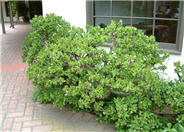
Common name:Jade Plant
Botanical name:Crassula ovata
Crassula ovata is an evergreen shrub that grows to 2' to10' tall and 3' to 6' wide with light green leaves. It like full sun, low watering, and will live in any type of well drained soil.
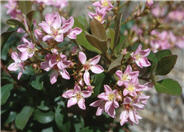
Common name:Indian Hawthorne
Botanical name:Rhaphiolepis indica
This small shrub will grow 2' tall and 4' wide. It has small, dark green leaves that get a red tint in the winter and deep pink flowers that bloom fall through spring.

Common name:New Zealand Flax selections
Botanical name:Phormium cultivars
New Zealand Flax is a large, bold plant with stiffly vertical, sword-like, green leaves that arise from its base. It should be grown under full sun for best color. Varieties will offer different growth habits and leaf color.
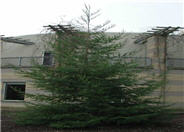
Common name:Coast Redwood
Botanical name:Sequoia sempervirens
This fast growing, aromatic tree has soft, dark green foliage with long needles appearing in flat sprays and brown, barrel-shaped cones that appear after 1 year. Its soft, red-brown bark is fiberous and furrowed. Particularly after mechanical damage, this tree will stump sprout to form new, young trees around the stump. Avoid planting in areas of high foot traffic.
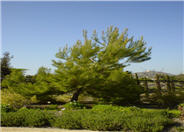
Common name:Allepo Pine
Botanical name:Pinus halepensis
The Pinus halepensis exhibits moderate growth to 30' or more, with an open, irregular crown. The long needles are doubled and light green in color, with a length of 2.5"- 4" long. Pines are highly combustible plants.
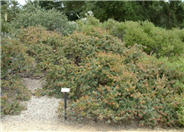
Common name:John Dourley Manzanita
Botanical name:Arctostaphylos 'John Dourley'
This small, low growing shrub has grayish green leaves with pink and white flowers that bloom in winter and early spring.
Sustainable Fertilization
If you mulch heavily as recommended in the compost and mulch fact sheets you should not need traditional fertilization. Sustainable landscapes fertilize themselves as soil organisms break down and recycle the dropped leaves into nutrients.
Click in the green box for more information
| Designer: Anon | Shrubs Along the Sidewalk |
Photographer: GardenSoft |
Soils and Compost:
Maintain a two to four inch layer of mulch on the soil surface to reduce weeds, infiltrate rain water, and reduce compaction.
Integrated Pest Management:
Remove irrigation water and fertilizer from areas where you don't want weeds to grow.

